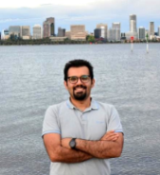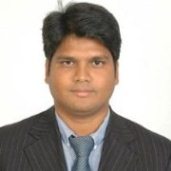Title (Tutorial 1)
Deep Reinforcement Learning in Vision-Language
Dr. Qi Wu and Dr. Ehsan Abbasnejad,
University of Adelaide, Australia
Abstract
The Visual Dialogue task requires an agent to engage in a conversation about an image with a human. It represents an extension of the Visual Question Answering task in that the agent needs to answer a question about an image, but it needs to do so in light of the previous dialogue that has taken place. The key challenge in Visual Dialogue is thus maintaining a consistent, and natural dialogue while continuing to answer questions correctly. In this talk, I will first present an approach that combines Reinforcement Learning (RL) and Generative Adversarial Networks (GANs) to generate more human-like responses to questions. I will then discuss how to reshape the reward function in the RL to generate better questions in a goal-oriented dialogue task.
Deep Reinforcement Learning is an important area in machine learning that has gained momentum due to wide range of applications. Reinforcement learning seeks to learn by interacting with the environment which sets it apart from conventional supervised learning. In this tutorial, we will provide a theoretical and practical introduction to reinforcement learning. We will discuss various popular algorithms employed for reinforcement learning and their applications. In particular, we will focus on dialog systems where the agent interacts with humans using natural language to achieve a goal. We will discuss how to frame dialog systems as a reinforcement learning task and train an intelligent agent.

Dr. Qi Wu,
University of Adelaide, Australia
Short Biography
Dr. Qi Wu is a Senior Lecturer in the University of Adelaide and he is an Associate Investigator in the Australia Centre for Robotic Vision (ACRV). He is the ARC Discovery Early Career Researcher Award (DECRA) Fellow between 2019-2022. He obtained his PhD degree in 2015 and MSc degree in 2011, in Computer Science from the University of Bath, United Kingdom. His educational background is primarily in computer science and mathematics. He works on the Vision and Language problems, including Image Captioning, Visual Question Answering, Visual Dialog etc. His work has been published more than 30 papers in prestigious journals and conferences such as TPAMI, CVPR, ICCV, AAAI and ECCV.

Dr. Ehsan Abbasnejad,
University of Adelaide, Australia
Short Biography
Dr. Ehsan Abbasnejad is a Lecturer in the University of Adelaide and is a member of Australian Institute for Machine Learning. He was awarded his PhD degree in 2015 in Computer Science from the Australian National University. His expertise is mainly in machine learning, in particular generative methods and reinforcement learning.
Title (Tutorial 2)
3D Urban Feature Extraction and Mapping with Geospatial Artificial Intelligence Techniques
Prof. Dr. Biswajeet Pradhan and Dr Maher Ibrahim Sameen,
University of Technology Sydney, Australia
Abstract
A number of machine learning methods have been proposed in recent years for the extraction and mapping of urban features from remote sensing data. Research on automated feature extraction methods, such as deep learning (e.g., convolutional neural networks), remote sensing based mapping, and 3D urban modelling, has improved and increased significantly. This workshop offers an in-depth tutorial on these topics, including theoretical concepts for the practical implementation of state-of-the-art methods. In five days' time, you will learn (i) how feature extraction methods are used in GIS for urban mapping, (ii) how to construct and train supervised classifiers to extract land cover information from remote sensing images, (iii) how to perform even more advanced feature extraction methods, and (iv) how to develop deep learning models and apply them for urban mapping, and (v) finally how to use convolutional neural networks for making 3D urban maps using remote sensing data such as images and digital elevation models. Upon learning these principles, spatial data processing and analysis in practice, you can easily find your path to more advanced topics in urban remote sensing and machine learning.

Prof. Dr. Biswajeet_Pradhan,
University of Technology Sydney, Australia
Short Biography
Distinguished Professor Biswajeet Pradhan is an internationally established scientist in the field of Geospatial Information Systems (GIS), remote sensing and image processing, complex modelling/geo-computing, machine learning and soft-computing applications, natural hazards and environmental modelling and remote sensing of Earth observation.
He is the Director of the Centre for Advanced Modelling and Geospatial Information Systems (CAMGIS) at the Faculty of Engineering and Information Technology in University of Technology Sydney.
He is also the distinguished professor at the University of Technology, Sydney
He is listed as the World’s most Highly Cited researcher by Clarivate Analytics Report in 2018, 2017 and 2016 as one of the world’s most influential mind. In 2018, he has been awarded as World Class Professor by the Ministry of Research, Technology and Higher Education, Indonesia. He is a recipient of Alexander von Humboldt Research Fellowship from Germany. In 2011, he received his habilitation in “Remote Sensing” from Dresden University of Technology, Germany. Since February 2015, he is serving as “Ambassador Scientist” for Alexander Humboldt Foundation, Germany.
Professor Pradhan has received 55 awards since 2006 in recognition of his excellence in teaching, service and research. Out of his more than 450 articles, more than 450 have been published in science citation index (SCI/SCIE) technical journals. His H-index is 70 (Scopus) with more than 14,800 citations. He has written eight books and thirteen book chapters. He is the Associate Editor and Editorial Member in more than 8 ISI journals.
He has completed 23 research projects amounting to USD 14 Million. He is a member of many international professional bodies such as Committee of Space research (COSPAR), Senior Member of IEEE, United Nations Outer Space Research Programme (UNOOSA) and many more. He sits as board member of many national programs in South-East Asia. He is a regular reviewer for many international bodies alike European Science Foundation, Dutch Research Council, Austrian Science Foundation, Research Council UK (RCUK), Swiss National Science Foundation, Belgian Remote Sensing Program and many more.
He has supervised 37 PhD students (21 graduated, 15 as primary supervisor); 10 MSc students (with thesis), 9 graduated as primary supervisor; and 30 MSc students by course work.
Professor Pradhan has widely travelled abroad visiting more than 52 countries to present his research findings.

Dr. Maher Ibrahim Sameen,
University of Technology Sydney, Australia
Short Biography
Dr. Maher Ibrahim Sameen is a postdoctoral research fellow at the School of Information Systems and Modelling, UTS. He is fuelled by his passion for developing algorithms for remote sensing and geospatial applications. His background in surveying engineering, geomatics, and remote sensing inform his mindful but competitive approach. He has published over 19 journal articles indexed in Web of Science, attended 9 conferences, and won three awards.